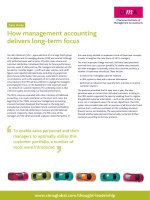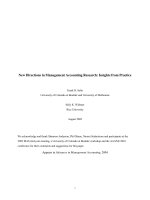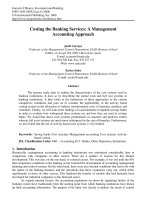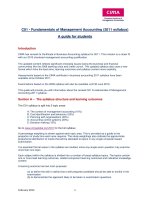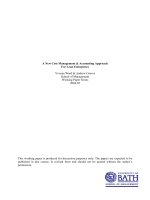How management accounting delivers long-term focus
Bạn đang xem bản rút gọn của tài liệu. Xem và tải ngay bản đầy đủ của tài liệu tại đây (107 KB, 2 trang )
www.cimaglobal.com/thought-leadership
Van den Udenhout (VdU – www.udenhout.nl) is a large Dutch group
of car dealers and its managing director (MD) was worried. Although
VdU performed quite well in terms of profits, sales volume and
customer satisfaction, he believed the basis for future performance
was very weak. In daily practice, the managers and salesmen of VdU
focused on monthly targets – profit and sales volume– and profit
figures were reported retrospectively, excluding any projections
about future performance. VdU was very vulnerable to external
circumstances, such as the popularity of its models and economic
circumstances. The MD had the ambition to change the managers’
and employees’ focus on the dealership’s most important asset
– its network of customer relations. The underlying vision is that
customer loyalty secures long run financial performance.
The MD’s concerns resonated with other criticisms of traditional
accounting –too much orientation on the short term. Since the
beginning of the 1990s, several new management accounting
concepts had been developed that focused on the long-term
and external orientation. Examples include customer profitability
analysis, non-financial performance measures and the balanced
scorecard. Inspired by these concepts, the MD, some of the
managers and the CIMA sponsored academic researcher/author of
this case study, decided to implement some of these new concepts
in order to lengthen the time frame of VdU’s managers.
The most important change was each individual sales personnel
now had their own customer portfolio. To enable sales personnel
and their managers to optimally utilise this customer portfolio, a
number of tools were introduced. These include:
• a protocol for managing customer relations
• a CRM-system to deal with customer information
• performance indicators that quantify their activities to improve
customer relations.
The protocol prescribed that at least once a year, the sales
personnel were to contact their individual customers. In doing so,
the CRM-system supported the sales by enabling them to register
the gathered customer information – such as the intention to buy
a new car or complaints about the service department. The CRM-
system also provided sales with an overview of all the products and
services that a customer purchased at VdU, including insurance,
finance, service and bodyshop. The new performance indicators
showed whether sales personnel had actually contacted all their
customers according to the new protocol.
How management accounting
delivers long-term focus
Casestudy
To enable sales personnel and their
managers to optimally utilise this
customer portfolio, a number of
tools were introduced.
Many activities were organised to help sales adjust to the new
requirements of VdU’s senior management including:
• workshops and presentations about the new vision concerning
the maintenance of customer relations
• individual meetings of members of the project team and sales
personnel.
In addition, workshops and individual meetings were also held
for managers of the sales personnel. After about six months, the
performance indicators concerning the maintenance of customer
relations showed the vast majority of the sales personnel contacted
their customers, as defined in the protocol.
However, there were considerable differences between the
dealerships in the maintenance of customer relations. In one of the
dealerships, the approach was very prescriptive. Sales personnel
simply contacted the customers in their portfolio by phoning on
time and discussing the issues with their customers. In another
dealership, the mentality was more proactive. The sales personnel
of this dealership not only behaved according to the protocol, they
also developed their own initiatives to improve their relations with
customers in their portfolio. Some even took care of all customer
complaints, even when the complaints did not concern the sales
department. Another sales person ensured that their customers
visited the showroom each time they came to the dealership for
service. In this dealership there were numerous initiatives beyond
the scope of VdU’s protocols to improve customer relations.
When introducing the change, all of VdU’s dealerships, the
protocols, performance indicators, information systems, workshops
and individual meetings were the same. All the activities senior
managers usually do to realise a change were executed. However,
the dealerships differed considerably in the success of the
change. These differences cannot be explained by the accounting
information or the way in which this information was introduced.
The exchange of more fine-grained information explained the
differences between the dealerships. In the dealership which most
successfully adapted to senior management’s new vision, there was
a continuous and informal exchange of fine-grained information.
The project team’s office was next to the dealership. The MD and
the members of the project team informally discussed their ideas
in the corridor, during lunch and at the coffee machine. The result
was a shared understanding of senior management’s revised vision,
which eventually led to the definition of new protocols, a new
customer information system and new performance indicators. This
shared understanding was also facilitated by sales personnel being
able to develop their own initiatives in line with the new vision.
Many new concepts in management accounting assume there
will be a causal link between accounting indicators and targeted
results. For example, the underlying assumption of the balanced
scorecard is that high performance on non-financial performance
indicators will lead to high financial performance. This case proves
the relationship between actual behavior of sales personnel at work
floor level and a complex goal as maintaining customer relations
is often too complex to communicate via an accounting system
– even if the whole organisation is trained extensively in using the
system. To realise complex purposes, less formal and less structured
forms of fine-grained information exchange are essential.
How management accounting
delivers long-term focus
Casestudy
In the dealership which most
successfully adapted to senior
management’s new vision,
there was a continuous and
informal exchange of
fine-grained information.
www.cimaglobal.com/thought-leadership

